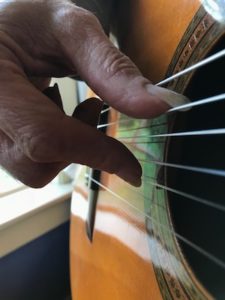Single String Etude #3 – vibration in the top

Vibration is all
Why do we play guitar – or music in fact? To feel vibration. That’s all it is. No vibration equals no sound, no feel, no emotion, no joy or sorrow. Nothing. So what matters most is to vibrate your guitar to the maximum. How? By plucking. That’s what we do. But how you pluck is the secret.
Pressing instead of plucking

The i finger presses firmly into 2nd string while thumb dampens bass E and prepares to play the fifth
Watch the video below to gain insight into how I touch the strings, or rather how I press the strings into the top for full vibration. Normally called rest stroke, the act of pressing and releasing the string engages the full potential of your guitar. We don’t want to hear nylon vibrate, we want wood! Don’t grab the string and pull it. You need to release a vibration that transfers the maximum amount of energy from your finger (your intent!) into the wooden body of the guitar. Why pay thousands of dollars for gorgeous exotic woods and then fail to engage fully with the instrument. Too many folks today buy loud guitars so that they can play lightly. This is nonsense!
Maximum vibration
Primarily the vibration set up in the string causes the soundboard to vibrate. Sympathetic vibration follows in all parts of the guitar that are intended to vibrate. I say “intended to vibrate” because different styles of construction have very different resonances. Some modern guitars intentionally limit the vibration of the back and sides. Whereas traditional guitar design employs sympathetic resonance between all parts of the guitar – even the neck and fingerboard.
The quality of the vibration is entirely dependent on the quality of our stroke. The shape of your nails and angle of attack are crucial. But it is the attitude of approach which accomplishes the most satisfying results. Meet the resistance in the string and the top itself with the full force of arm, hand and finger. Feel a sense of weight pushing into the string. The smooth release over nail surface is crucial, but is a separate issue. It is covered ever so thoroughly by Bill Kanengiser in his video at Learning with Legends. It is excellent and features Bill’s thorough knowledge and classic sense of humor.
Simplicity leads to success
Single String Etudes are designed with simplicity that allows even advanced guitarists to focus on very basic but satisfying musical goals. In previous videos we have talked about shifting smoothly, vibrato, and rest stroke in the thumb. This video discusses classic rest stroke in the fingers and how to make the most of it. These basic concepts effect how we balance a simple two voice texture. That perhaps 90% of what we do on the guitar. More will follow on how to hear and play polyphonic textures.
Recent Comments